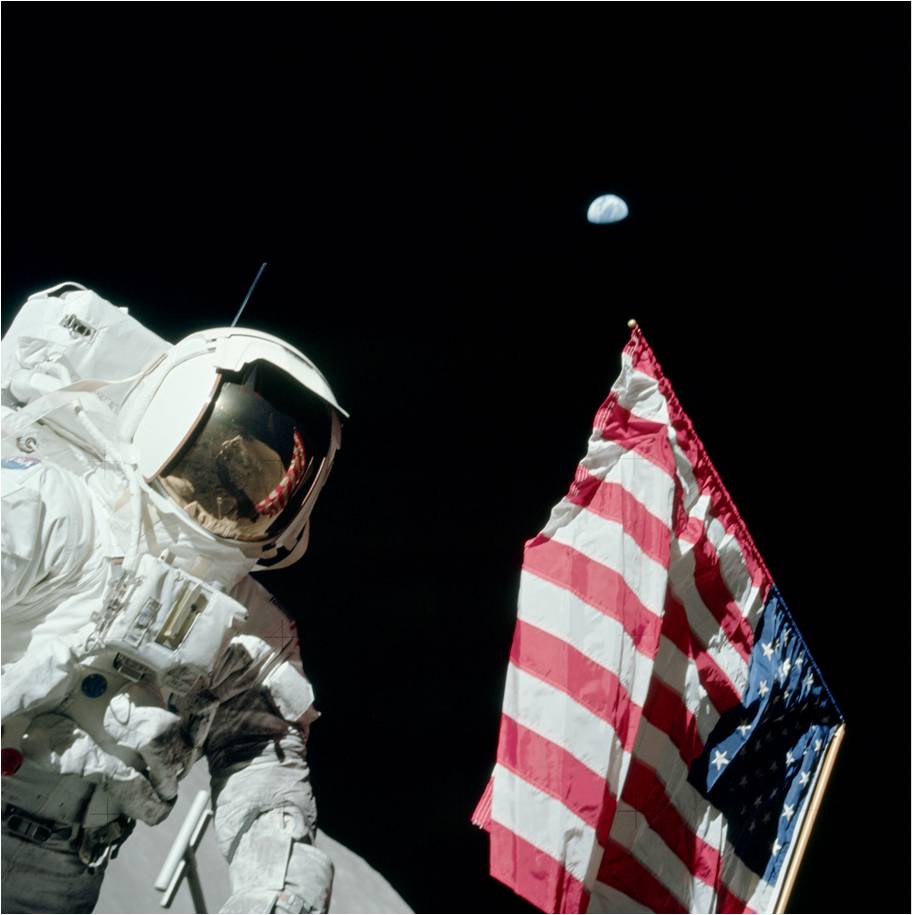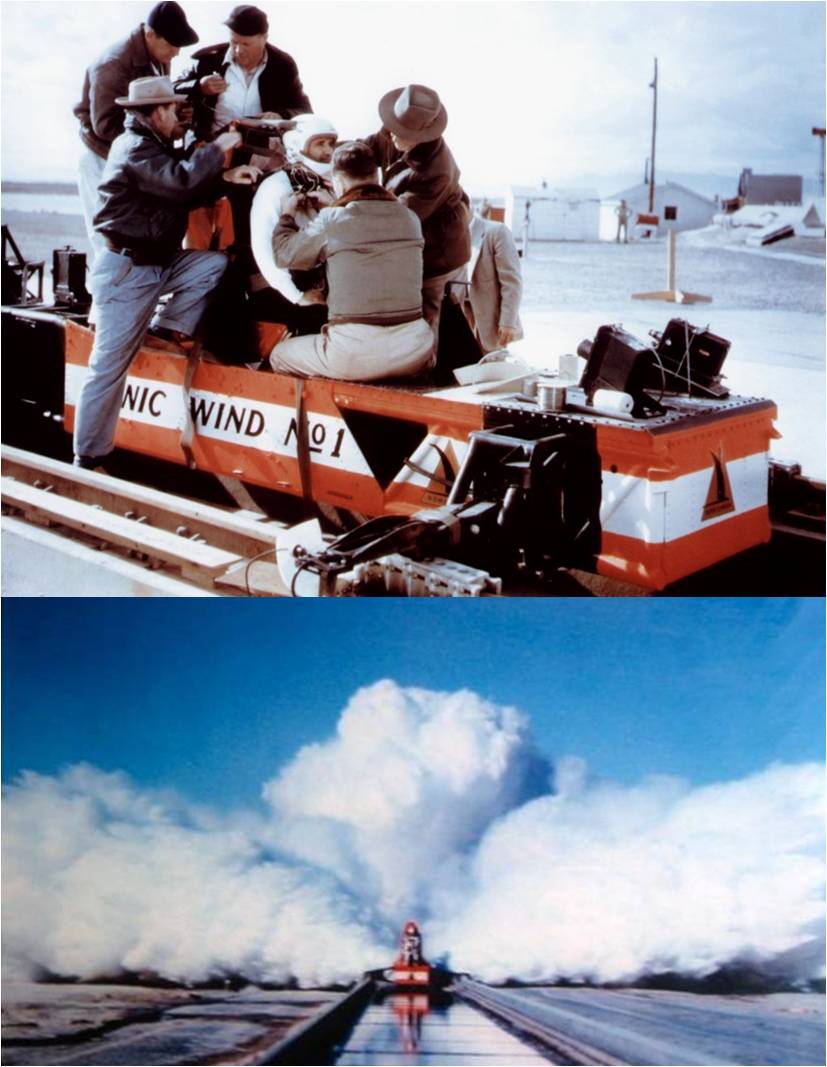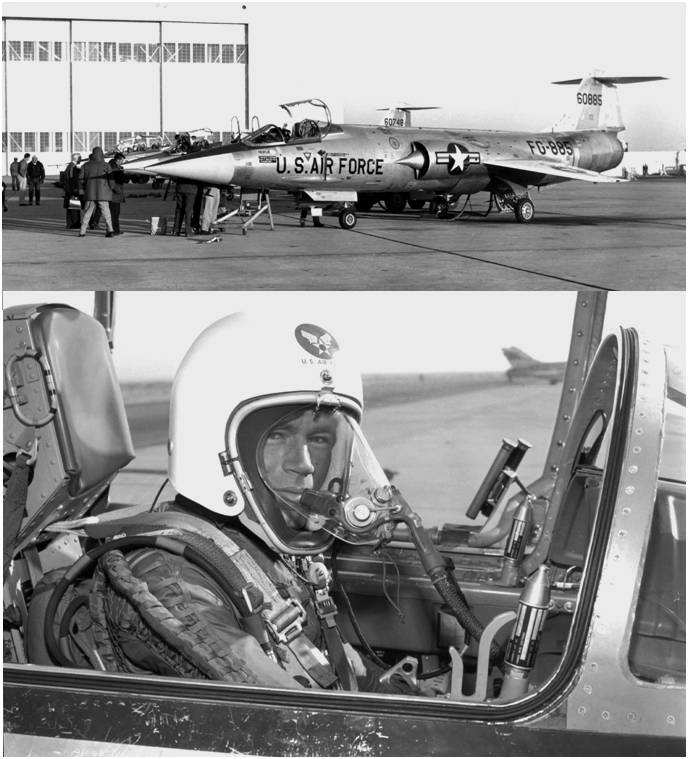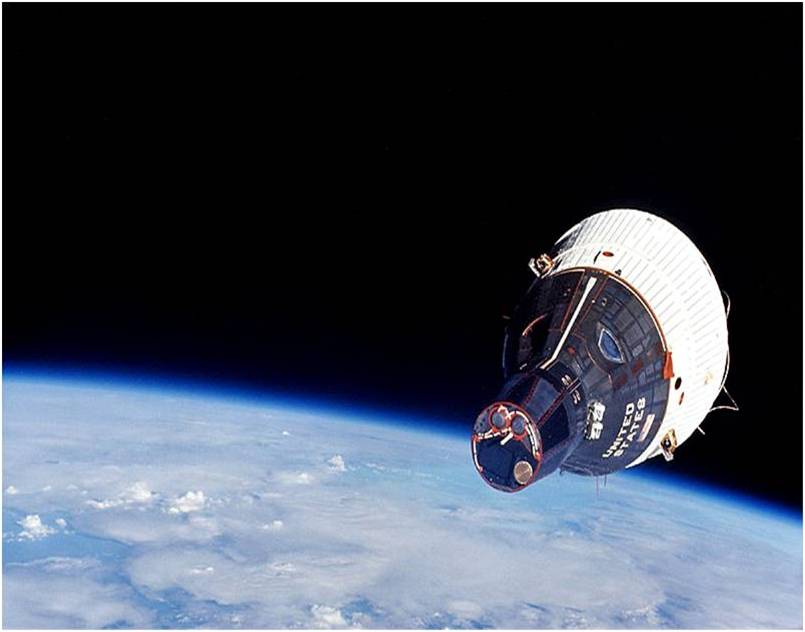
Thirty-eight years ago this month, NASA successfully conducted the sixth lunar landing mission of the Apollo Program. Known as Apollo 17, the flight marked the last time that men from the planet Earth explored the surface of the Moon.
Apollo 17 was launched from LC-39A at Cape Canaveral, Florida on Thursday, 07 December 1972. With a lift-off time of 05:33:00 UTC, Apollo 17 was the only night launch of the Apollo Program. Those who witnessed the event say that night turned into day as the incandescent exhaust plumes of the Saturn V’s quintet of F-1 engines lit up the sky around the Cape.
The target for Apollo 17 was the Taurus-Littrow valley in the lunar highlands. Located on the southeastern edge of Mare Serenitatis, the landing site was of particular interest to lunar scientists because of the unique geologic features and volcanic materials resident within the valley. Planned stay time on the lunar surface was three days.
The Apollo 17 crew consisted of Commander Eugene A. Cernan, Command Module Pilot (CMP) Ronald E. Evans and Lunar Module Pilot (LMP) Harrison H. Schmitt. While this was Cernan’s third space mission, both Evans and Schmitt were space rookies. Astronaut Schmitt was a professional geologist and the only true scientist to explore the surface of the Moon.
With Evans circling the Moon solo in the Command Module America, Cernan and Schmitt successfully landed their Lunar Module Challenger at 19:54:57 UTC on Monday, 11 December 1972. Their lunar stay lasted more than three days. The astronauts used the Lunar Rover for transport over the lunar surface as they conducted a trio of exploratory excursions that totaled more than 22 hours.
Cernan and Schmitt collected nearly 244 pounds of lunar geologic materials while exploring Taurus-Littrow. As on previous missions, the Apollo 17 crew deployed a sophisticated set of scientific instruments used to investigate the lunar surface environment. Indeed, the Apollo Lunar Surface Experiments Package (ALSEP) deployed during during lunar landing missions measured and transmitted vital lunar environmental data back to Earth through September 1977 when the data acquisition effort was officially terminated.
The Apollo 17 landing party departed the Moon at 22:54:37 UTC on Thursday, 14 December 1972. In a little over two hours, Challenger and America were docked. Following crew and cargo transfer to America, Challenger was later intentionally deorbited and impacted the lunar surface. The Apollo 17 crew then remained in lunar orbit for almost two more days to make additional measurements of the lunar environment.
At 23:35:09 UTC on Saturday, 16 December 1972, Apollo 17 blasted out of lunar orbit and headed home. Later, CMP Ron Evans performed a trans-Earth spacewalk to retrieve film from Apollo 17 ‘s SIM Bay camera. Evans’ brave spacewalk occurred on Sunday, 17 December 1972 (69th anniversary of the Wright Brothers first powered flight) and lasted 65 minutes and 44 seconds.
Apollo 17 splashdown occurred near America Samoa in the Pacific Ocean at 19:24:59 UTC on Tuesday, 19 December 1972. America and her crew were subsequently recovered by the USS Ticonderoga.
Apollo 17 set a number of spaceflight records including: longest manned lunar landing flight (301 hours, 51 minutes, 59 seconds); longest lunar stay time (74 hours, 59 minutes, 40 seconds); total lunar surface extravehicular activity time (22 hours, 3 minutes, 57 seconds); largest lunar sample return (243.7 pounds), and longest time in lunar orbit (147 hours, 43 minutes, 37 seconds).
Apollo 17 successfully concluded America’s Apollo Lunar Landing Program. Of a sudden it seemed, America’s — and the world’s — greatest adventure was over. However, the anticipation was that the United States would return in the not-too-distant future. Indeed, Gene Cernan, the last man to walk on the Moon, spoke the following words from the surface:
“As I take man’s last step from the surface, back home for some time to come — but we believe not too long into the future — I’d like to just [say] what I believe history will record — that America’s challenge of today has forged man’s destiny of tomorrow. And, as we leave the Moon at Taurus-Littrow, we leave as we came and, God willing, as we shall return, with peace and hope for all mankind. Godspeed the crew of Apollo 17.”
It has now been 38 years since the Commander of Apollo 17 spoke those stirring words from the valley of Taurus-Littrow. Gene Cernan and most space experts of his day figured we would surely be back by now. Certainly in the 20th century. Yet, there has been no return. Moreover, there is no formal plan or funded program in the 21st century to do so. And so, the historical record continues to list the name of Eugene A. Cernan as the last man to walk on the Moon.
Okay America, here’s some questions for you. When will we go back to the Moon? By extension, how about Mars and beyond? Are our greatest space achievements behind us or is the best yet to come? Are we a nation of used-to-be’s or are we that bastion of freedom where even the impossible is achievable? Does it matter? Do you even care? You choose.

Fifty-six years ago this month, USAF Lieutenant Colonel John Paul Stapp set a record for human G-tolerance when his Sonic Wind #1 rocket-powered test sled decelerated from 632 mph to a full stop in roughly 1.4 seconds. In so doing, Stapp endured a deceleration load equal to 46.2 times his weight.
The period immediately following World War II marked the beginning of a steady rise in the speed and altitude capabilities of military aircraft. These performance increases subjected aircrew to wider ranges of flight loads and physical stresses. Manifold aeromedical issues and crew safety concerns arose; particularly in the area of emergency escape from a stricken aircraft.
Abandoning an aircraft in flight under emergency conditions and surviving the experience has always been a sporty proposition. Ejection forces, wind blast, body limb flailing, parachute opening shock levels, and the like make it so. Add to this list the effects of atmospheric temperature, pressure and oxygen concentration, and one starts to get an appreciation for the severity of the situation.
John Paul Stapp was a USAF physician who had an abiding interest in the aeromedical aspects of emergency escape. He knew that too many pilots were dying in situations that could have been survivable if proper equipment and procedures were available. Stapp dedicated himself to improving the chances of aircrew survival.
Stapp was a pioneer in scientifically investigating the effects of acceleration and deceleration on the human body. In March of 1947, he began a series of deceleration tests using a 2,000-foot sled track at Edwards Air Force Base. A rocket-powered test sled named the Gee Whiz carried test subjects down the track and brought them to a sudden halt to produce specific deceleration levels.
Initially, Stapp’s test subjects were anthropomorphic dummies and primates. However, he had always held to the belief that the best test subject would be a human. Better yet, a human who possessed extensive medical knowledge. Stapp selected himself for the assignment.
Stapp took his first ride down the Edwards sled test track on Wednesday, 10 December 1947. By May of 1948, he had riden the Gee Whiz a total of 16 times. One run resulted in a deceleration of 35-G’s. This meant that Stapp briefly experienced a force equal to 35 times his normal body weight during deceleration. In so doing, he pointedly dispelled the prevailing notion that a human being could not survive a deceleration level beyond 18-G’s.
Riding the sled was a form of physical abuse. Among numerous injuries, Stapp received several concussions, broke the same wrist twice, cracked ribs, and sustained retinal hemorrhages for his time on the track. All in an effort to find ways to preserve the lives of aircrew. Stapp, other human volunteers and chimpanzees continued sled testing on the Edwards track until 1953.
Stapp transferred to the Aeromedical Field Lab at Holloman Air Force Base, New Mexico in early 1953. He now had a longer track (3,550 feet) and a faster sled (Sonic Wind #1) with which to expand his deceleration research. The system was checked-out using a new crash test dummy and then a live primate. Stapp made the first human run on the Holloman track.
John Paul Stapp completed his 29th and final experimental sled test run on Friday, 10 December 1954. Propelled by a set of 9 rocket motors producing 70,000 pounds of thrust, the Sonic Wind #1 hit a peak velocity of 632 mph (Mach 0.9 at the test site altitude). Stapp endured a maximum acceleration of 20 G’s and then an incredible peak deceleration of 46.2-G’s during 1.4 seconds of slow-down. At that moment, he weighed 6,800 pounds.
Stapp took a severe pounding during his record ride. There were the “usual” body bruises, lacerations and harness burns. However, the worse effects involved his eyes. Both hemorrhaged and were completely filled with blood. Stapp indicated that all he could see was a watery salmon-colored fluid. Happily, his vision would return to quasi-normal by the next day. Stapp sported a pair of world-class shiners as peculiar momentos of his extreme deceleration experience.
Characteristically, Stapp had plans to go faster and endure more G’s. Indeed, the proposed Sonic Wind #2 test sled would be capable of driving him in excess of 1,000 mph and decelerating at more than 80 G’s. Such was not to occur as USAF would not allow Stapp to risk all again as a sled test subject.
John Paul Stapp’s legendary work produced enormous dividends in helping develop equipment, techniques and procedures that have saved the lives of countless aircrew. But the benefits of his research have gone well beyond that. Today, automobile safety standards are based in large measure on Stapp’s pioneering deceleration work. His legacy continues in other ways as well. Indeed, the 54th Stapp Car Crash Conference was held in November of this year.
John Paul Stapp, USAF officer, physician, sled test subject, was a man of uncommon valor and a bonifide hero in the truest sense of that over-used word. He willingly risked his life numerous times so that others might live. A man can do no more than that for his friends. On Wednesday, 13 November 1999, this man among men passed away peacefully in his sleep at age 89.

Fifty-one years ago this week, USAF Captain Joe B. Jordan zoomed a modified USAF/Lockheed F-104C Starfighter to a world altitude record of 103,395.5 feet above mean sea level. The flight originated from and recovered to the Air Force Flight Test Center (AFFTC) at Edwards Air Force Base, California.
On Tuesday, 14 July 1959, the USSR established a world altitude record for turbojet-powered aircraft when Soviet test pilot Vladimir S. Ilyushin zoomed the Sukhoi T-43-1 (a prototype of the Su-9) to an absolute altitude of 94,661 feet. By year’s end, the Soviet achievement would be topped by several American aircraft.
FAI rules stipulate that an existing absolute altitude record be surpassed by at least 3 percent for a new mark to be established. In the case of the Soviet’s 1959 altitude record, this meant that an altitude of at least 97,501 feet would need to be achieved in a record attempt.
On Sunday, 06 December 1959, USN Commander Lawrence E. Flint wrested the months-old absolute altitude record from the Soviets by zooming to 98,561 feet. Flint piloted the second USN/McDonnell Douglas YF4H-1 (F4 Phantom II prototype) in accomplishing the feat. In a show of inter-service cooperation, the record flight was made from the AFFTC at Edwards Air Force Base.
Meanwhile, USAF was feverishly working on its own record attempt. The aircraft of choice was the Lockheed F-104C Starfighter. However, with the record now held by the Navy, the Starfighter would have to achieve an absolute altitude of at least 101,518 feet to set a new mark. (Per the FAI 3 percent rule.)
On Tuesday, 24 November 1959, the AFFTC accepted delivery of the record attempt aircraft, F-104C (S/N 56-0885), from the Air Force Special Weapons Center at Kirtland AFB in New Mexico. This aircraft was configured with a J79-GE-7 turbojet capable of generating nearly 18,000 pounds of sea level thrust in afterburner.
Modifications were made to the J79 to maximize the aircraft’s zoom kinematic performance. The primary enhancements included increasing afterburner fuel flow rate by 10 percent and maximum RPM from 100 to 103.5 percent. Top reset RPM was rated at 104.5 percent. Both the ‘A’ and ‘B’ engine flow bypass flaps were operated in the open position as well. These changes provided for increased thrust and stall margin.
An additional engine mod involved reducing the minimum engine fuel flow rate from 500 to 250 pounds per hour. Doing so increased the altitude at which the engine needed to be shut down to prevent overspeed or over-temperature conditions. Another change included increasing the maximum allowable compressor face temperature from 250 F to 390 F.
The F-104C external airframe was modified for the maximum altitude mission as well. The compression cones were lengthened on the bifurcated inlets to allow optimal pressure recovery at the higher Mach number expected during the record attempt. High Mach number directional stability was improved by swapping out the F-104C empannage with the larger F-104B tail assembly.
USAF Captain Joe B. Jordan was assigned as the altitude record attempt Project Pilot. USAF 1st Lt and future AFFTC icon Johnny G. Armstrong was assigned as the Project Engineer. Following an 8-flight test series to shake out the bugs on the modified aircraft, the record attempt proper started on Thursday, 10 December 1959.
On Monday, 14 December 1959, F-104C (S/N 56-0885) broke the existing absolute altitude record for turbojet-powered aircraft on its 5th attempt. Jordan did so by accelerating the aircraft to Mach 2.36 at 39,600 feet. He then executed a 3.15-g pull to an inertial climb angle of 49.5 degrees. Jordan came out of afterburner at 70,000 feet and stop-cocked the J79 turbojet at 81,700 feet.
Roughly 105 seconds from initiation of the pull-up, Joe Jordan reached the top of the zoom. The official altitude achieved was 103,395.5 feet above mean sea level based on range radar and Askania camera tracking. True airspeed over the top was on the order of 455 knots. Jordan started the pull-up to level flight at 60,000 feet; completing the recovery at 25,000 feet. Landing was entirely uneventful.
Jordan’s piloting achievement in setting the new altitude record was truly remarkable. His conversion of kinetic energy to altitude (potential energy) during the zoom was extremely efficient; realizing only a 2.5 percent energy loss from pull-up to apex. Jordan also exhibited exceptional piloting skill in controlling the aircraft over the top of the zoom where the dynamic pressure was a mere 14 psf. He did so using aerodynamic controls only. The aircraft did not have a reaction control system ala the X-15.
Armstrong’s contributions to shattering the existing altitude record were equally substantial. Skillful flight planning and effective use of available resources (including time available for the record attempt) were pivotal to mission success. Armstrong significantly helped maximize aircraft zoom performance through proper selection of pull-up flight conditions and intelligent use of accurate day-of-flight meteorological information.
For his skillful piloting efforts in setting the world absolute altitude record for turbojet-powered aircraft in December of 1959, Joe Jordan received the 1959 Harmon Trophy.
Posted on December 8, 2010 by
skyhookWhite Eagle Aerospace (WEA) held its highly acclaimed Aerodynamics For Engineers (AFE) short course at Edwards Air Force Base, California from 29 Nov-02 Dec 2010. This specialized training was provided to military and civilian engineering personnel of the legendary Air Force Flight Test Center (AFFTC).
White Eagle Aerospace sincerely appreciates the opportunity to serve the aerospace training needs of the United States Air Force. Special thanks to John Welker, Linda Harrison and Agie Castillo for making WEA’s AFFTC experience such a memorable one.

Class Photo
Aerodynamics For Engineers Short Course
Air Force Flight Test Center (AFFTC)
Edwards Air Force Base, Californa
29 Nov-02 Dec 2010

Forty-five years ago this month, Gemini 7 set a new record for long-duration manned spaceflight. The official lift-off-to-splashdown flight duration was 330 hours, 35 minutes and 1 second.
Project Gemini was the critical bridge between America’s fledging manned spaceflight effort – Project Mercury – and the bold push to land men on the Moon – Project Apollo. While the events and importance of this program have faded somewhat with the passage of time, there would have been no manned lunar landing in the decade of the 1960’s without Project Gemini.
On Thursday, 25 May 1961, President John F. Kennedy addressed a special session of the U.S. Congress on the topic of “Urgent National Needs”. Near the end of his prepared remarks, President Kennedy proposed that the United States “should commit itself to achieving the goal, before this decade is out, of landing a man on the moon and returning him safely to the earth.”
At the time of the President’s clarion call to go to the Moon, the United States had accrued a total of 15 minutes of manned spaceflight experience. That quarter hour of spacefaring activity had come just 20 days previous. Indeed, Alan B. Shephard became the first American to be launched into space when he rode his Freedom 7 Mercury spacecraft on a sub-orbital trajectory down the Eastern Test Range on Tuesday, 05 May 1961.
America responded enthusiastically to the manned lunar landing goal. However, no one really knew exactly how to go about it! After considering several versions of direct ascent from the Earth to the Moon, NASA ultimately decided to use a method proposed by engineer John C. Houbolt known as Lunar Orbit Rendezvous (LOR). As a result, NASA would have to invent and master the techniques of orbital rendezvous.
Project Gemini provided the technology and flight experience required for a manned lunar landing and return. In the 20 months between March of 1965 and November of 1966, a total of 10 two-man Gemini missions were flown. During that time, the United States learned to navigate, rendezvous and dock in space, fly for long durations and perform extra-vehicular activities.
The primary purpose of Gemini 7 was to conduct a 14-day orbital mission. This was important since the longest anticipated Apollo mission to the Moon and back would be about the same length of time. Gemini 7 was flown to show that men and spacecraft could indeed function in space for the required period. A secondary goal of Gemini 7 was to serve as the target for Gemini 6 in achieving the world’s first rendezvous between two manned spacecraft.
Gemini-Titan (GT-7) lifted-off from Cape Canaveral’s LC-19 at 19:30:03 UTC on Saturday, 04 December 1965. The Gemini 7 flight crew consisted of Commander Frank F. Borman II and Pilot James A. Lovell, Jr. They were successfully inserted into a 177-nm x 87-nm low-earth orbit. This initial orbit was later circularized to 162-nm.
Borman and Lovell spent the first 10-days of their mission conducting a variety of space experiments. They wore special lightweight spacesuits that were supposed to improve confort level for their long stay in space. However, these suits were not all that comfortable and by their second week in space, the astronauts were flying in just their long-johns.
On their 11th day in space, the Gemini 7 crew had visitors. Indeed, Gemini 6 was launched into Earth orbit from Cape Canaveral and subsequently executed the first rendezvous in space with Gemini 7 on Wednesday, 15 December 1965. Gemini 6, with Commander Walter M. Schirra, Jr. and Pilot Thomas P. Stafford on board, ultimately maneuvered to within 1 foot of the Gemini 7 spacecraft.
While Gemini 6 returned to Earth within 24 hours of launch, Gemini 7 and her weary crew soldiered on. The monotony was brutal. Borman and Lovell had conducted all of their planned space experiments. They had to drift through space to conserve fuel. They couldn’t sleep because they weren’t tired. Borman later indicated that those last 3 days on board Gemini 7 were some of the toughest of his life.
On the 14th day of flight, Saturday, 18 December 1965, Borman and Lovell successfully returned to Earth. Reentry was entirely nominal. Splashdown occurred at 14:05:04 UTC in the Atlantic Ocean roughly 400 miles east of Nassau in The Bahamas. Crew and spacecraft were recovered by the USS Wasp.
Frank Borman and Jim Lovell had orbited the Earth 206 times during their 14-day mission. Each crew member was tired and a little unsteady as he walked the flight deck of the USS Wasp. However, each man quickly recovered his native strength and vitality.
The 14 days that the Gemini 7 crew spent in space were physically and emotionally demanding. Life within the cramped confines of their little spacecraft was akin to two guys living inside a telephone booth for two weeks. Notwithstanding the challenges of that spartan existence, the Gemini 7 crew did their job. Gemini 7 was a resounding success. More, Project Gemini had achieved another key milestone. The Moon seemed a bit closer.






